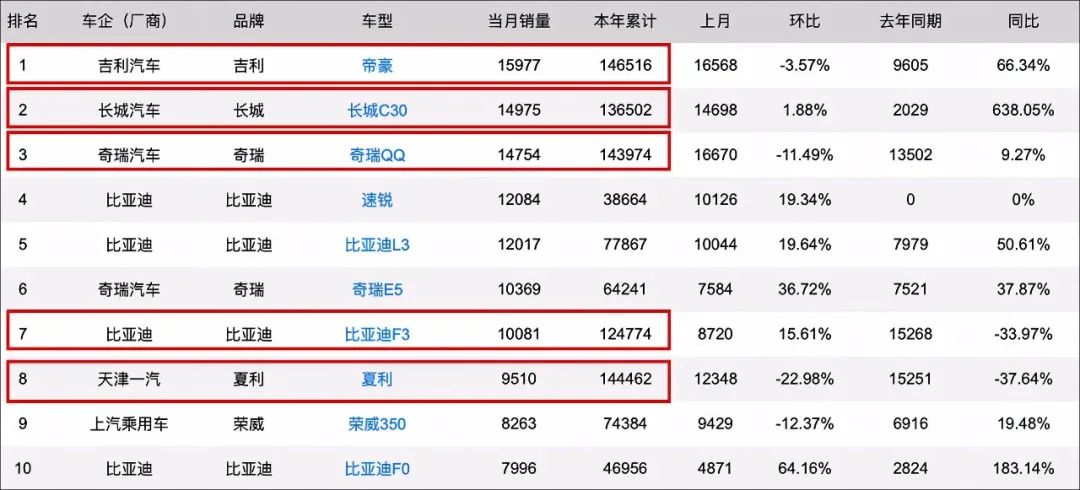文 | Karakush
Ten years ago, Chinese men’s football team spent a lot of money to go to Recife, Brazil to play a friendly match against Brazilian men’s football team.
The game ended with a score of 0-8, making it the most devastating defeat since 1936.
Han Qiaosheng said, “If the Brazilian team played more seriously, they could have won 10-0.”
At that time, it had been ten years since the shining moment when they qualified for the World Cup group matches. During this time, Chinese men’s football team hadn’t even made it to the top ten in Asia for the World Cup qualifying matches for three consecutive sessions.
Officially and among the public, there was a rare consensus that Chinese men’s football team was lagging behind in all respects.
Chinese cars ten years ago were similar to the Chinese men’s football team.
Take 2012 as an example, the top five selling Chinese cars were Geely EC7, FAW Xiali, Chery QQ, Great Wall C30, and BYD F3. Here’s a graph to illustrate:

Meanwhile, the top five joint venture models of the same year were Ford Focus, Buick Excelle, Chevrolet Sail, Volkswagen Lavida, and Volkswagen Jetta.
The rest will be left to the imagination.
Making cars and playing football are two trees in the spiritual garden of Chinese men.
One tree is Chinese Scholar tree and the other is also Chinese Scholar tree.
There’s a saying in the Huilan dialect that goes like this: when the Chinese Scholar tree is not doing well, no matter what you say, it will think you’re cursing it.
In fact, when the Chinese Scholar tree is really not doing well, no matter what you curse, you’ll end up cursing the tree.
That’s how the domestic market in China has always been. Germans and Japanese look down on others and ridicule other joint ventures together. Other joint ventures refuse to admit that they’re second-rate and ridicule Chinese cars together. Chinese cars have nobody to ridicule except for the weak ones among themselves or to ridicule Chinese men’s football team–at least they haven’t lost to it.
In 2022, Chinese men’s football team hasn’t forgotten their roots, but Chinese cars have never been as excellent as they are today.
According to the China Association of Automobile Manufacturers, Chinese brand passenger cars sold a total of 4.891 million units in the first half of this year, a year-over-year increase of 16.5%, higher than the overall growth rate of the passenger car market by 3.4%, and a market share of 47.2%.
The last time the market share was higher than 45% was in 2010, when there was a surge in growth due to the automobile subsidies policy, but apart from that, they had nothing to offer except being inexpensive.
And this time, their brands, reputation and market share are all flying high.
In fact, this visible reversal has only happened in the past two to three years.
From 2019 to 2020, China’s car market was in a slump, with market share below 40%. A young person asked on Zhihu, “Should I buy a Chinese brand car?” Both acquaintances and bloggers advised against it. They received 468 replies with barbed comments.# A New Automotive Industry Leader Emerges in China – BYD
Every time someone criticizes the Chinese automotive industry, it only takes three seconds before the strongest “self-made” entrepreneur in the universe, BYD, shows up to give a lesson.
What has happened in the past two years? Is it true prosperity or just an industry trend? Who is leading China’s automotive industry? Is it a miracle for a small business in the current era, or can it be seen as a growth model that will lead China’s automotive industry to prosperity?
The Industry Leader
In the past 20 years, every time the market experienced a drastic change, a new industry leader emerged. The industry leader is not only one who is good at seizing market opportunities, but also reflects the logic of growth driving all Chinese automotive companies.
The first industry leader was Chery. From the early 2000s until 2012, it demonstrated China’s speed and ability to produce low-priced cars. It also highlighted the hard truth that Chinese consumers value quality, but not necessarily at the expense of lower prices.
The Chinese automotive industry usually launches a large number of new cars into the mainstream market, using reverse engineering to support rapid expansion, and promoting maximum growth through the positive effects of new car releases. However, due to technological limitations and brand ambiguity, Chinese carmakers struggle with competition when facing limited growth potential.
When foreign carmakers launch an average of 10 new models each year and one-third can be established in their respective markets as well-known products, Chinese carmakers that compete in the same price range will find it difficult to keep up, as seen in the case of the Sail, Verna, and Kia K2.
Since 2010, the marginal benefit of pushing new car releases began to decline and was completely ineffective in 2014, as Chinese brand cars’ market share fell below 20% for the first time.
The second industry leader was Great Wall and Changan, which realized the potential market limitations of sedans and turned to SUVs from 2012 to 2016. Chinese-brand SUVs began to rapidly expand, peaking when the domestic SUV market reached 10 million units in 2017 and Chinese automakers attained a historic high share of 60%.
The current growth is fundamentally still extensional but has one characteristic where China’s automotive industry faces internal differentiation. Lesser-known players continue to rely on exploring unconventional opportunities, while established players are beginning to focus on creating products that employ positive development. They invest heavily in powertrains and exterior design, nurturing fist products such as Haval H6 or Changan CS75.Even if the SUV market has reached its saturation point, German, Japanese, and American automakers are entering a strong new vehicle cycle, and China’s overall automotive market share is starting to decline. The leading players in the industry have developed internal capabilities to resist external factors, such as the decline in the market. For example, the two largest companies have remained stable in the top three.
From 2017 to 2021, the overall automotive market declined, and the third-generation leader, Geely, represented the system’s ability to win. With the early realization of the acquisition of Volvo technology, combined with its insistence on producing both sedans and SUVs, it has not only broken through a million units in the context of micro-incremental or negative incremental growth and consumer upgrading, but also consistently maintained its position at 1.2 million.
From this, we can summarize several rules:
First, early growth is almost entirely due to new demand. Chinese companies are more responsive to demand, and joint ventures take a few years to invest, during which time many companies may enter the market. Those who are more prepared and better positioned to capitalize on the market will become the top companies.
Second, market changes will inevitably bring about a restructuring of the market order. No one can be strong forever, and in just one or two years, things can turn upside down. Even the established leading companies can fall behind, and it is almost irreversible.
Third, the market capacity determines the development ceiling. Once joint ventures enter the market, it is difficult for Chinese auto companies to maintain an absolute advantage. Especially when facing strong joint ventures, they are still in a weak position, with either weak sales, weak prices, or both.
Fourth, after 2018, the market pattern has stabilized, and for three or four years, there has been no new demand. Everyone is seeking to achieve more intensive growth within existing capacity. The Matthew effect has intensified, and competition depends on the system. The situation is basically the same. Therefore, by 2021, the top three have announced their 2025 sales targets: 4 million (Great Wall), 3.65 million (Geely), and 3 million (Changan). Compared to their respective sizes at the time, the compound annual growth rate is very aggressive, but this does not mean it is unreasonable.
By 2022, it was proven that everyone underestimated new energy vehicles. This is the fourth dramatic change in the market, and Byton became the leader.
What makes Byton a leading player?
At one time, Byton was a leading Chinese company, along with Geely and Great Wall, representing outstanding private enterprises. However, due to its misguided business strategy, it stagnated as an average-sized enterprise, selling only 30,000 units per month and having a scale of only four to five hundred thousand units per year, for nearly ten years. By 2016, it was left on the sidelines by the top tier players.
In 2020, it had not yet entered the mainstream auto association’s top 15 rankings. In 2021, it suddenly surged 73% to 13th place, and in the first half of this year, it increased by 168% year-on-year, jumping to second place, and beating the mainstream automakers’ average of -9.6% negative growth.The growth curve of new energy vehicles keeps consistent with the penetration rate. Before 2020, new energy vehicles saw a crawling growth with a high year-on-year growth rate but a small volume. However, in 2021, they penetrated to 13%, and BYD’s new energy vehicle sales exceeded those of traditional fuel vehicles for the first time. By 2022, the penetration rate will reach over 20%, and BYD will stop selling fuel vehicles altogether.
For BYD itself, there are two reasons for its take-off this year: in the short term, its vertically integrated and decentralized supply chain can ensure business continuity during the pandemic while Tesla and other competitors were completely halted. In the long term, it completed its system and scale preparation before the outbreak of the new energy vehicle market, allowing it to quickly match the mainstream market of 150,000 to 300,000 RMB.
As for specific companies’ analysis, it will not be further elaborated here.
What needs to be emphasized here is that this is another extensional growth brought about by newly added market demands. Chinese automakers responded the fastest, and companies that were most thoroughly prepared were able to break through and become leaders in scale. So this is not just BYD’s victory. Anyone can ride the wave of opportunity and transform from a bicycle into a motorcycle. We can look at Chery. In the first half of this year, its new energy vehicle sales exceeded 100,000, accounting for more than one-third of its total sales, which is very high compared to its peers, and achieved a year-on-year growth of 14.9%, finally entering the top 15.
Compared with the past, several external conditions are jointly driving the current growth of the Chinese automobile industry.
Firstly, there is a change in the consumer group. In 2020, the first batch of people born in the year 2000 became adults, and those born in 1995 began to have large consumption power or demand. Compared with their predecessors who almost have no memory of Chinese-made cars during the Chinese national football era, they are not only not opposed to Chinese-made cars but even prefer them due to the rise of cross-sectoral domestic trends since 2015 and a stronger unified ideology reshaping the consumption habits of new groups.
Secondly, the “girl group” effect has followed suit. The pioneer automaker, NIO, started delivering its first car in 2018 and can achieve stable output by 2020. Its high-end product has successfully opened up the 300,000 to 400,000 RMB market, making “Chinese automobile high-end technology” a reality. This paved the way for BYD to introduce its technology label of blade batteries in 2020.
Thirdly, the target is relatively centralized. From 2019 to 2020, many traditional automobile companies completed a round of elimination. The implementation of China VI a year in advance disrupted the pace of many small companies. Chinese companies were generally slower to prepare than joint ventures by 1 to 2 quarters, while the long-tail companies were unprepared and even had no cars to sell. Even if they managed to produce a car, the cost per vehicle increased on average by 2,000 to 2,500 yuan, making it impossible to pass on the extra costs.
Therefore, many miraculous operations appeared around 2020. Zotye’s subsidiaries and factories hung banners every day; Haima sold real estate to raise money; Lifan sold idle production qualifications to Ideal for quick turnover. In the end, however, they still had to file for bankruptcy restructuring, including Beiqi Yinxiang, Huachen, and Leopard, all of which were once great.## Market Concentration Improved in 2020, with the Top 15 Mainstream Enterprises Accounting for 78% of the Market Share, Up Four Percentage Points from the Previous Year.
It has to be said that a piece of virgin land has been left for the new energy sector.

Who Will Be the Next Leader in the Field?
In the past, market changes were either dominated by the East Wind or the West Wind. But this pattern has obviously become ineffective in the new energy field.
The current joint venture is slow, as it has always been. The speed of China’s new energy vehicle process is fast, currently accounting for 39.8%, surpassing any decent sample of a joint venture.
Even though the relative advantage will shrink after the supply chain is restored, the trend will not change. The powertrain of traditional core competitiveness will no longer be restricted to the ceiling of new energy vehicles.
Moreover, Chinese automobile companies are pulling ahead in many dimensions. They have a better understanding of Chinese consumers’ psychology, are better at using diversified marketing methods, and pay more attention to communication and interaction with consumers during the marketing process.
For example, digitization may have been just a gimmick in the past, but now the digitization transformation of product channels, customer interactions, and operational processes has become a new trend. It requires a technology team that can quickly design and deploy digital solutions and an agile organization that can adapt to process and demand changes. Organizational adjustment is difficult for large enterprises, but the challenge for joint ventures is much greater than for Chinese enterprises.
As for who can replace BYD in the future, there may be two possibilities:
One is Tesla. No explanation needed.
Another is waiting for the next wave of market changes.
In the current market orbit, other Chinese enterprises with strong layouts, such as Changan and Geely, may be able to achieve sniping in some products and segments of the market, such as the Deep Blue SL against the Seal. However, it is difficult to shake BYD’s vertical integration. Even if the next growth point for Chinese enterprises is in global business, BYD’s leadership position will continue.
The opportunity lies in intelligentization. This will form the next wave of new demand after new energy. Based on the possibility of technological reserves + scale, the candidates are Xiaomi, Huawei, or possibly NIO (dog head).
But these are still far away.
At present, the greatest pressure is on those companies that are falling behind. There isn’t much time for adjustment. Either work hard to catch up and feel embarrassed if you can’t get big in one or two years, or bet on the future to go all in on intelligence. Maybe there will be a chance to turn things around in four or five years.
During the days of enduring humiliation, the Chinese men’s football team was at the bottom, but it was not shameful.
This article is a translation by ChatGPT of a Chinese report from 42HOW. If you have any questions about it, please email bd@42how.com.
